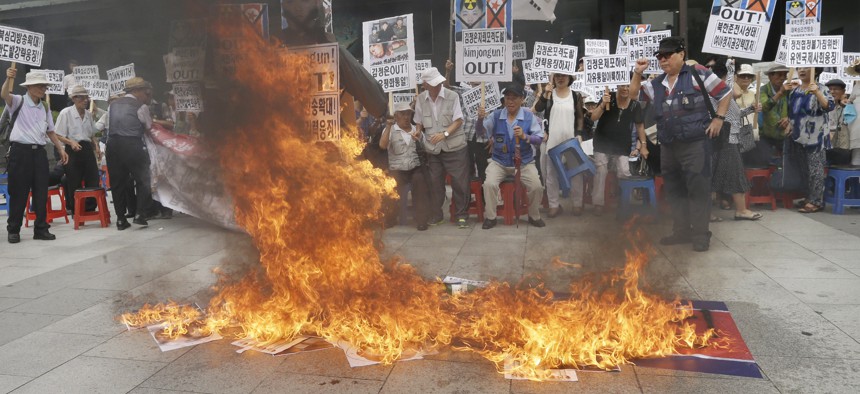
South Korean protesters burn an effigy of North Korean leader Kim Jong Un and a North Korean flag in Seoul, South Korea. AP Photo/Ahn Young-joon
Artillery, Protests, and Giant Balloons Mark Rising Korean Tensions
North and South Korea, locked in one of the world’s most intractable conflicts, exchanged fire on Thursday.
Tensions along the inaptly named “demilitarized zone” on the border between North and South Korea flared up on Thursday, as the two countries exchanged rocket and artillery fire for the first time since 2010. The incident—which caused no injuries—was an escalation in a recent series of incidents along the border. On August 4, the South Korean government accused the North of planting land mines along the border that wounded two South soldiers.
Thursday’s incident also reinforced the uniquely powerful role that propaganda plays in driving the Korean conflict, which has remained unresolved following the 1953 ceasefire that ended the Korean War. Following the land-mine injuries earlier this month, the South revived a dormant practice of broadcasting messages through loudspeakers alongside the border, something it had not done in 11 years. The North retaliated in kind, threatening the South with war.
South Koreans also brought back the years-old practice of releasing balloons into the sky. South Korean activists insert messages written in Korean into the tall, cylindrical tubes, and then release them into North Korean territory. Traditionally, these balloons have only a modest effect on their intended audience—North Koreans tend to be suspicious of propaganda messages delivered by non-government actors. The balloons can also contain objects such as DVDs, USB sticks, and even chocolates—giving the isolated northerners a glimpse into the world beyond their borders.
“When North Koreans see high-quality consumer goods produced overseas, they begin to understand that their economic system doesn't really deliver,” Andrei Lankov, a worldwide leader in North Korean expertise, told the BBC in 2012 of the benefits of dispatching the balloons.
But opponents of the balloon drops claim that such forms of “psychological warfare” are an unnecessary provocation of the North Korean regime, who regards the drops as an “act of war.” In addition, there’s reason to believe that residents of North Korea are less starved of outside information than before. Increasing numbers of North Koreans regularly traverse the country’s porous border with China and return to their country with smuggled goods like televisions, DVD players, and radios. According to interviews with defectors, North Koreans have even developed a taste for American television shows likeDesperate Housewives. Propaganda from the South, may, in some cases, be little more than an unwanted and unneeded intrusion from the outside.
(See also: North Korea’s Missile Test Is Less Impressive Than You Think)
Seoul, for its part, has urged leaflet-distributing activists—some of whom are North Korean defectors themselves—to cease releasing the balloons. But the use of loudspeakers is an indication that the government has no desire to curtail its propaganda efforts entirely.
NEXT STORY: Don’t Let the Iran Deal Become 2016’s Swift Boat



